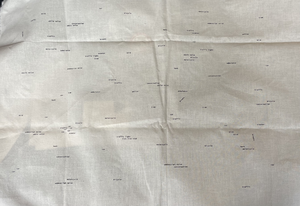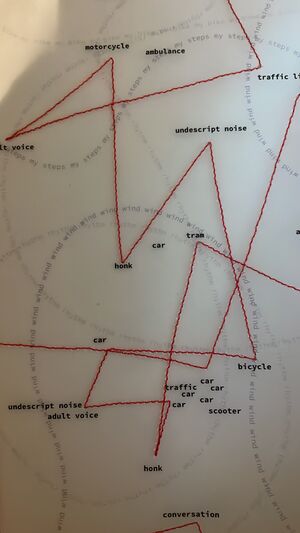User:Anita!/more things: Difference between revisions
No edit summary |
|||
| Line 79: | Line 79: | ||
Plan: | Plan: | ||
research the interactive fabric construction | |||
talk to people at fabric and interaction station | talk to people at fabric and interaction station | ||
weave a small patch and connect it with microcontroller and push sensors | weave a small patch and connect it with microcontroller and push sensors | ||
= | ==Gathering more info== | ||
I went to intarsia knitting and metal station skills. From the knitting, i was able to ask more about the machines available, if i can use conductive material with the machines and also more info around the technique of intarsia, which would allow me to knit in patterns without having to have dragging threads in the back, making the work much lighter (and much less expensive). I was also able to ask more about the possibility of spinning my own conductive yarn there, also a possibility that would allow me to have much bigger array of choices when it comes to color, thickness and material used in combination with the conductive thread. | |||
I was also looking into the possibility of maybe making my own conductive thread. Since it is made out of steel or stainless steel alloy, I am curious wether i could spin the conductive wool using the thread in combination with natural fibers instead of buying readymade conductive yarn. | |||
==Resources!== | |||
[https://wwww.com/How-to-make-conductive-thread/ Make your own conductive thread] | |||
[https://blog.sparkfuneducation.com/5-crafty-ways-to-make-diy-sewable-electronic-sensors Soft circuits] | |||
[https://www.kobakant.at/DIY/?p=7722 Conductive textile survival guide] | |||
[https://yuchenz.medium.com/tufting-with-conductive-thread-6ea197c3b54c Tufting with conductive thread] | |||
[adacad.org open-source design tool that applies the logics of parametric design to woven drafting available at] | |||
[https://unstable.design/prototyping-smart-textiles/_book/ huge library of information around experimental textiles] | |||
Revision as of 13:41, 16 October 2024
For now this is a page for the second year
Continuing the city soundscape
In the end, I ended up with a lot of recordings of solo walks and cycles. What to do with them? I listened to all of them, annotating what sounds I would hear.
These are two examples of the soundscape.
First, I tried on transparency paper, i liked the idea of attempting to create a small sewn zine with overlapping maps, but thinking back, after trying it, i ended up screenprinting this on cotton fabric, as it would allow for me to really use the material to my advantage, placing all the wondering walks and cycles on one singular map, instead of one route per map if that makes sense.
Now I will begin sewing the connections between the sounds, creating many layers.
I also like the idea of somehow also connecting the original audio files, but I am not sure yet of how and if i will do that. Maybe its nice to also just try to imagine the spacing between these sounds, the length of the walks, how close of far they feel, not hearing the sounds, but imagining what we remember they sound like. But lets see
Thinking about research
I want to continue working with sound in the context of public space, that I already know, but how? Listening is something I focused on a lot during the last Special Issue, and it is a topic that I know i want to experiment with more. While listening in the past, I have tried to focus on different aspects of it, for example, listening in a nominal way (yes sound, no sound), which forces you to focus on observing the rhythm of sound.
I also know that I want to incorporate some form of garment construction technique into the final project, but that relates more to the end representation project than the research itself.
PMMoMs
“Sound is pervasive, it spreads out in a space, connecting all bodies that it encounters. It is not an object or an attribute of an object but is generated by the reciprocal relationship between context object and subjects.” Elena Biserna in Going out
What?
A large scale textile soundboard (made as an interactive textile), containing a series of noises collected from public spaces. The soundboard can be played to create different city noise soundscapes, inviting the person playing with it to listen, move and imagine a path. Different points produce different sounds caught in the city. The person playing has to move and 'perform' because of the distance between the push sensors playing the sounds, enhancing the physicality aspect and physically embodying the soundscape.
Why?
Sound connects. It is not physical but exists so powerfully in space. It identifies places but is not usually thought of or used to describe one, other than the simple ‘noisy’ or ‘silent’. Imagining and playing with mundane sounds, exploring the landscape with no visual aid, to notice and create new imaginary paths.
Workflow
Select and record single sounds from most Rotterdam squares. At least 10 sounds, from thoughout the day. Record and pick the sounds to be used Design a soundboard Program the microcontroller Sew the circuit for it and connect Test and play by myself Adapt based on tests Test and play with public Adapt based on tests Readyyyyy
Timetable
October - recording and listening, early prototyping (drawing circuits, read more on interactive textiles) November - recording and listening, learn more about interactive textiles, do smaller projects involving them December - recording and listening, experiment with circuit connections, sewing circuits January - recording and listening, start testing on a smaller scale
Relation to previous practice (two sentences, draw on Text on Practice)
Listening, sewing, list making, noticing, moving and playing in public space.
Plan!
???
two different plans, that will enhance each other and inform each other. for research in book and research in public space. i would like the structure of the thesis to be kind of like a conversation between these two sides, kind of like sounds talking to each other.
Interactive textiles
Ways to make a textile interactive: - conductive ink screenprint (the area with ink could be connected to push or touch sensor) - metal fibers woven into fabric (possibility of spinning my own yarn to knit with for the soundboard) - optic fibers (according to https://textileinnovations.wordpress.com/research-focus-2/, "– transmit data signals, transmit light for optical sensing, detect deformations in fabrics due to stress and strain and perform chemical sensing.")
I still have to do extensive research on this, to properly select the best tool for me. It could be interesting to weave using re purposed optic fiber, to include pieces of the public infrastructure of the city into the piece itself but might be unrealistic as a thought.
Silkscreen printing would probably be the easiest option, but my least favorite one at this moment in time. The metal and conductive properties of the circuit soundboard being an actual part of the fabric, how it is constructed and flows seems much more organic and genuine to me, so even though it might potentially be more time consuming, I would prefer either weaving or knitting the circuit.
Plan:
research the interactive fabric construction talk to people at fabric and interaction station weave a small patch and connect it with microcontroller and push sensors
Gathering more info
I went to intarsia knitting and metal station skills. From the knitting, i was able to ask more about the machines available, if i can use conductive material with the machines and also more info around the technique of intarsia, which would allow me to knit in patterns without having to have dragging threads in the back, making the work much lighter (and much less expensive). I was also able to ask more about the possibility of spinning my own conductive yarn there, also a possibility that would allow me to have much bigger array of choices when it comes to color, thickness and material used in combination with the conductive thread.
I was also looking into the possibility of maybe making my own conductive thread. Since it is made out of steel or stainless steel alloy, I am curious wether i could spin the conductive wool using the thread in combination with natural fibers instead of buying readymade conductive yarn.
Resources!
Make your own conductive thread
Conductive textile survival guide
Tufting with conductive thread
[adacad.org open-source design tool that applies the logics of parametric design to woven drafting available at]


